I. Overview of Vietnamese religion
Vietnam represents a remarkable mosaic of religious diversity, hosting a broad spectrum of beliefs ranging from Buddhism, Confucianism, Taoism, and Christianity to Islam. The pivotal moment came in 1986 with the implementation of the "doi moi" policy, marking the country's shift towards economic liberalization. Concurrently, the government began to relax its stringent control over religious practices.
This liberalisation sparked a widespread religious renaissance throughout Vietnam. Buddhist pagodas, essential for worship, were restored to their former glory and vitality. Temples, once repurposed for secular uses, were rightfully returned to their religious communities.
The revival wasn't confined to physical structures; it also rekindled the celebration of long-forgotten religious festivals and rituals. Christian churches, both Roman Catholic and Protestant, witnessed such a surge in attendance that congregants spilled out into the streets.
For decades, the relationship between the Vietnamese government and organized religion was fraught with tension. Though the state has now eased restrictions on religious expression, it continues to monitor religious activities closely.
This newfound freedom has filled a void for many Vietnamese, offering them not just spiritual solace but also ideological guidance.
Furthermore, the blending of tradition and modernity is evident in practices such as consulting astrological charts for auspicious dates for significant events like weddings.
This amalgamation underscores the enduring significance of religion and tradition in contemporary Vietnamese society, illustrating a seamless integration of ancient customs with modern life.

Pagoda at Marble Mountains, Danang
II. Religion Fusion
Vietnam's religious landscape is as diverse as its culture, blending multiple beliefs into a unique spiritual mosaic. While it's common to think of Vietnam as primarily Buddhist, the truth is much more nuanced. Though around 85% of Vietnamese people visit Buddhist pagodas, strict adherence to Buddhism is much lower, with only about 16% of the population practicing Buddhism by the book.
In Vietnam, religious practices often overlap. It's not unusual for someone to pay respects to Buddha at a pagoda, honor a national saint at a temple, and remember a deceased grandparent at a family altar all in one go.
This blending extends even to Christians in Vietnam, who might participate in ancestor worship at home, alongside their church activities. Even those who consider themselves non-religious join in temple visits during festivals, highlighting the deep-rooted cultural aspect of these practices.
The Vietnamese spiritual landscape is shaped by a fusion of Asian religious traditions, including Taoism, Buddhism, and Confucianism, which have intertwined and adapted over time to form a core set of beliefs.
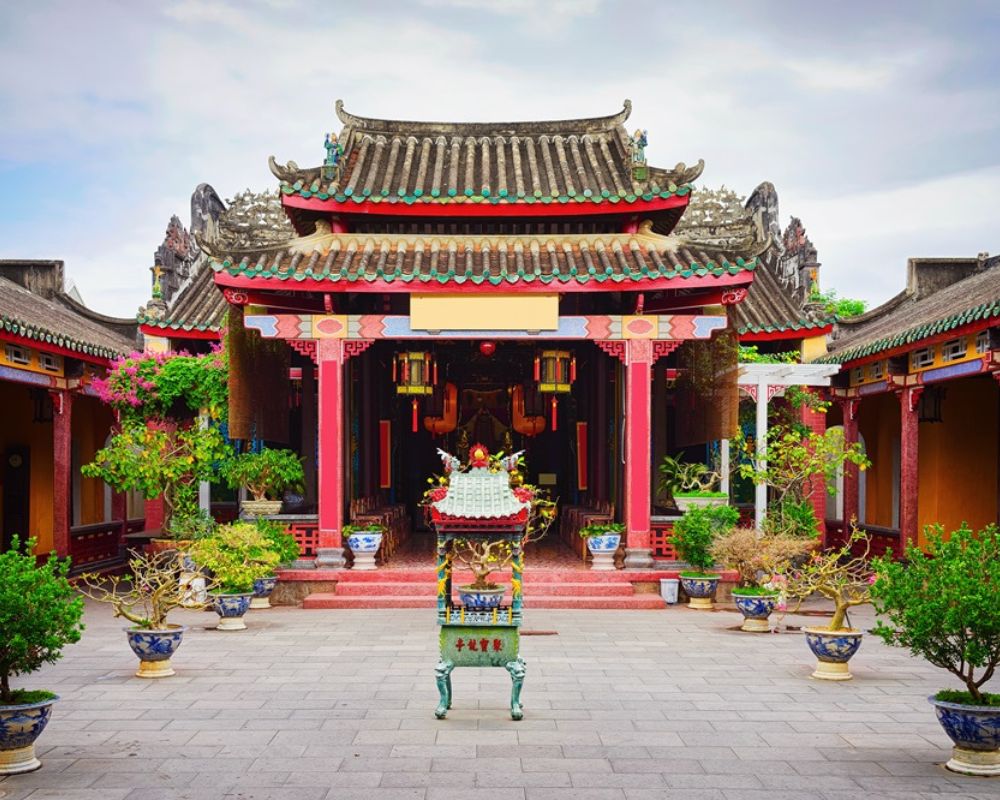
Hainan assembly hall in Hoian
In Vietnam, religious practices often intertwine in everyday life. It's not uncommon to see someone paying respects to Buddha at a pagoda, honoring a national hero at a temple, and commemorating a departed grandparent at a family altar, all in one day.
This blend even includes Christians in Vietnam, who may engage in ancestor worship at home, in addition to their church activities. Even those who identify as non-religious participate in temple visits during festivals, underscoring the profound cultural significance of these practices.
The spiritual landscape in Vietnam is shaped by a mixture of Asian religious traditions, including Taoism, Buddhism, and Confucianism, which have interwoven and adapted over centuries to form a foundational set of beliefs.
This foundation, often referred to as "tam giao" or the triple religion, incorporates elements of indigenous animism, adding layers of complexity. This amalgamation doesn't create a contradiction for the Vietnamese; rather, it forms a comprehensive spiritual perspective that influences everything from daily conduct to significant life decisions.
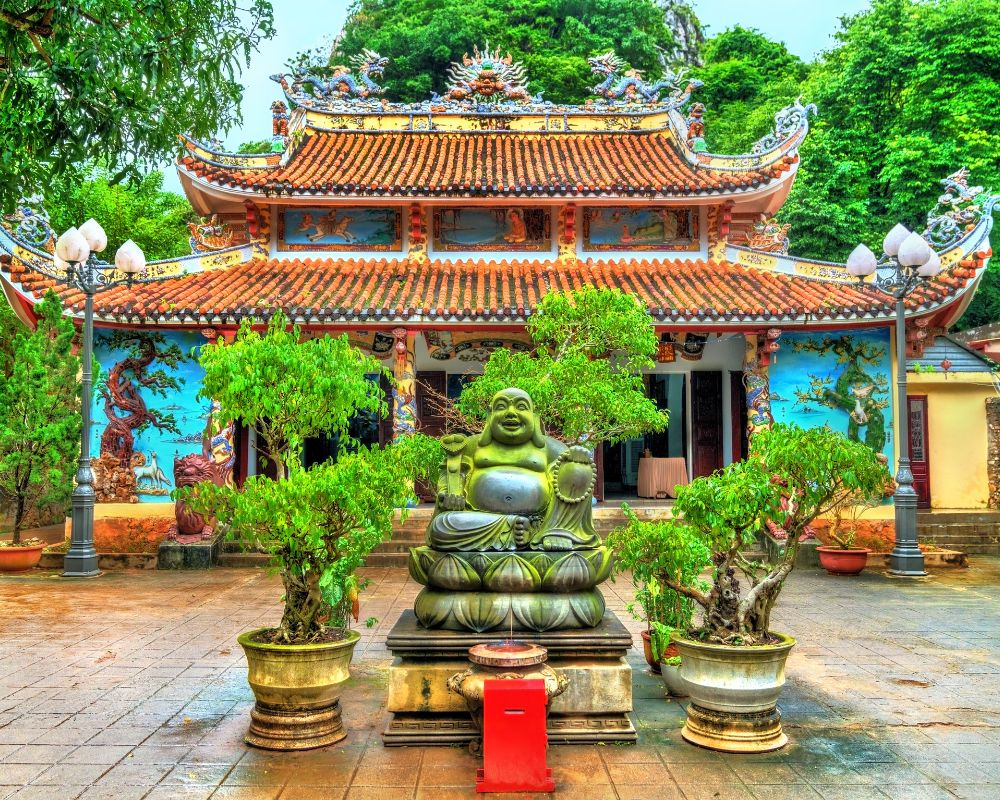
Buddhist temple on Marble Mountains
Vietnam also boasts its unique spiritual traditions, where the divine is believed to reside in the natural world, such as in mountains, rivers, and forests. These deities impact everything from architectural designs to the fortunes of individuals and communities, similar to the practice of feng shui in China.
This spiritual system is organized around three realms: heaven, earth, and humanity, each governed by its own set of rules and deities. Deities are omnipresent, dwelling in nature and honored through rituals and offerings.
This intricate blend of beliefs and practices showcases the depth and richness of Vietnamese spirituality, reflecting the country's history and cultural diversity.
>> Read more: Vietnam Hill Tribes Things You Need To Know
1. Chinese influence
The Chinese influence on Vietnam extends far beyond mere territorial control; it encompasses a vast transfer of agricultural knowledge, religious beliefs, philosophical ideas, and cultural practices.
The introduction of Chinese script, along with Confucianism, Taoism, and Buddhism, significantly shaped Vietnamese society, leaving a lasting imprint that is evident even today.
One of the most visible symbols of this influence is the small octagonal mirror adorned with the Yin Yang symbol found above the entrances of many Vietnamese homes and shops.
This talisman is believed to ward off evil spirits and ghosts, showcasing the deep-rooted impact of Chinese spiritual beliefs on Vietnamese daily life.
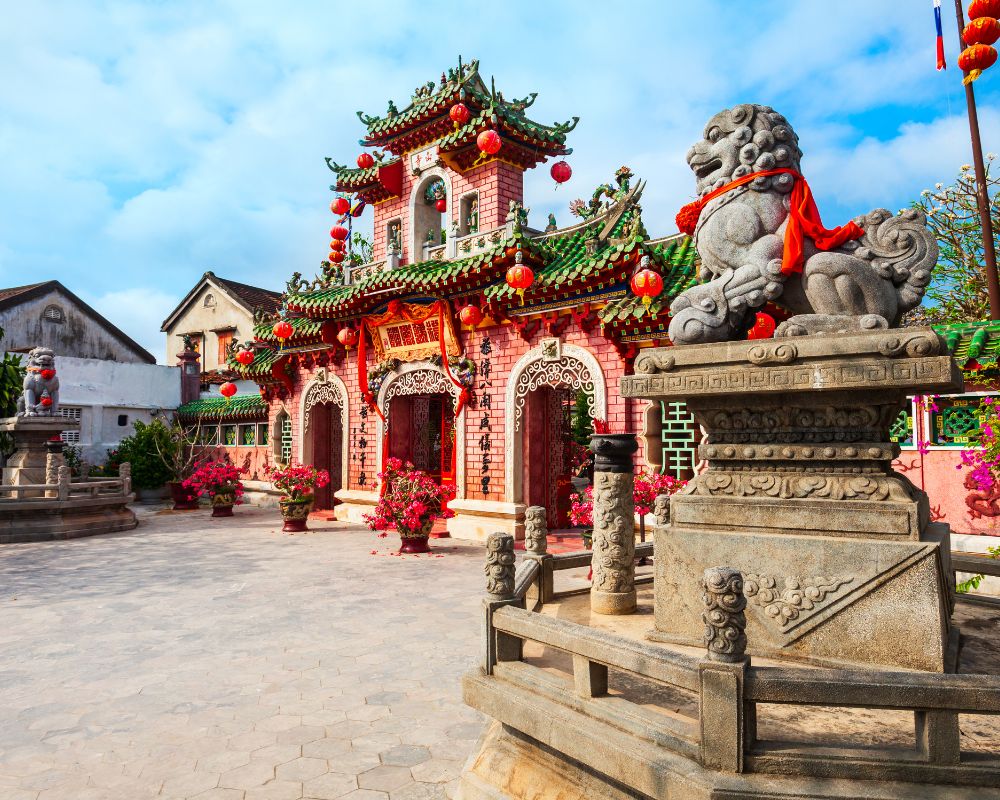
Chinese influence in Fukian assembly hall Hoian
2. Confucianism
Confucianism, a philosophy that emerged from the teachings of Confucius in northern China around 550 BC, places a significant emphasis on moral virtues and ethical conduct rather than on spiritual or mystical beliefs.
Confucius lived during a period marked by substantial political turmoil, dedicating his life to establishing a set of principles that would define the dynamics of various societal relationships—such as those between ruler and subject, among family members, and between teacher and student.
His teachings aimed to cultivate a society rooted in compassion, proper conduct, loyalty, knowledge, and trust, with a strong emphasis on social harmony and order.
As Confucianism spread to Vietnam over 2000 years ago, it profoundly shaped the Vietnamese moral landscape and spiritual life. The Vietnamese imperial dynasties, recognizing the philosophy's capacity to foster social order and harmony with minimal repression, officially embraced Confucianism's principles.
This adoption integrated Confucian values deeply into the fabric of Vietnamese society, influencing governance, education, and familial and social interactions.
Confucianism's emphasis on filial piety, respect for one's elders, and loyalty to the state became cornerstones of Vietnamese culture, shaping its development for centuries and continuing to influence Vietnamese society today.
Its principles of social mobility based on merit rather than birthright were particularly appealing, leading to the establishment of the imperial examination system. From 1706, these exams became the cornerstone of governmental recruitment, theoretically open to all men (excluding actors), and based purely on merit.
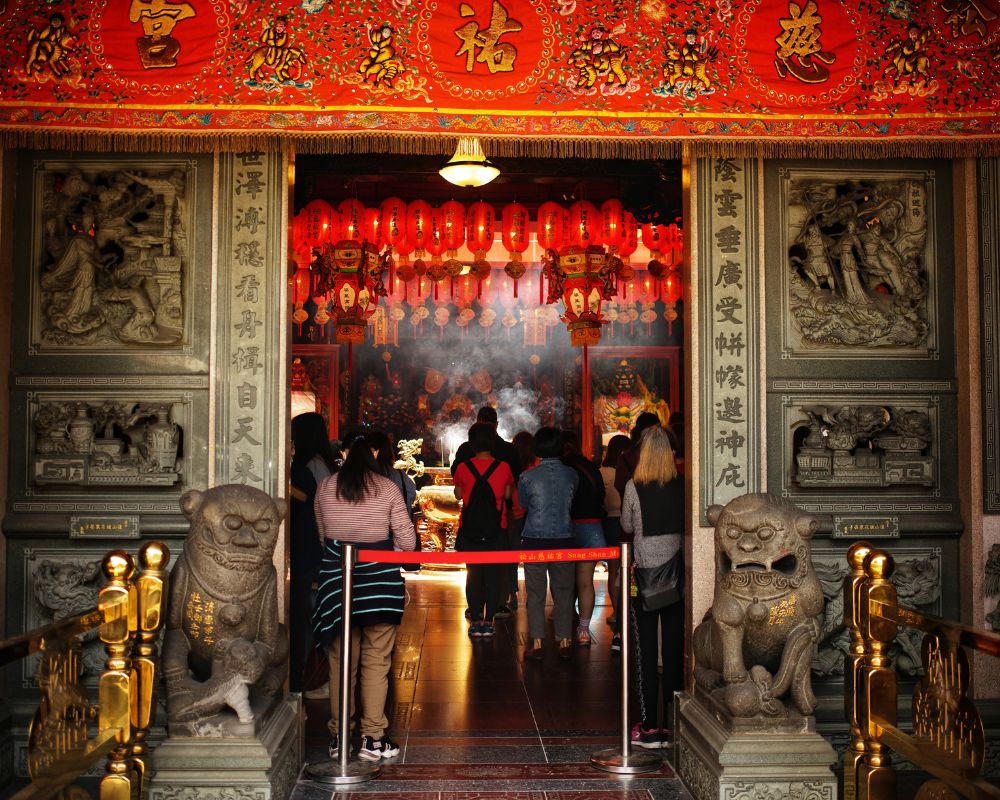
The temple has the Confucian architecture
Success in these exams was highly celebrated, with successful candidates receiving honors from the emperor and being hailed as wise scholars upon their return home. Conversely, those who didn't succeed often became teachers, thereby spreading Confucian teachings throughout Vietnamese villages.
This widespread education in Confucian principles helped cement its role as a pillar of Vietnamese society, shaping the nation's moral and ethical standards to this day.
3. Taoism
Taoism, emphasizing harmony between humans and the natural world, introduced the concept of the Tao as the fundamental principle underlying the universe, embodying both the path and the way of all things. In Vietnam, Taoism arrived alongside Confucianism but developed without the structured hierarchy of schools found in China.
It adds to the rich spiritual tapestry of Vietnamese villages, where it coexists with Buddhism, Confucianism, and animism, among other beliefs. The Tao, representing the fusion of yin and yang forces, is central to understanding the balance and flow of energy in the universe and life.
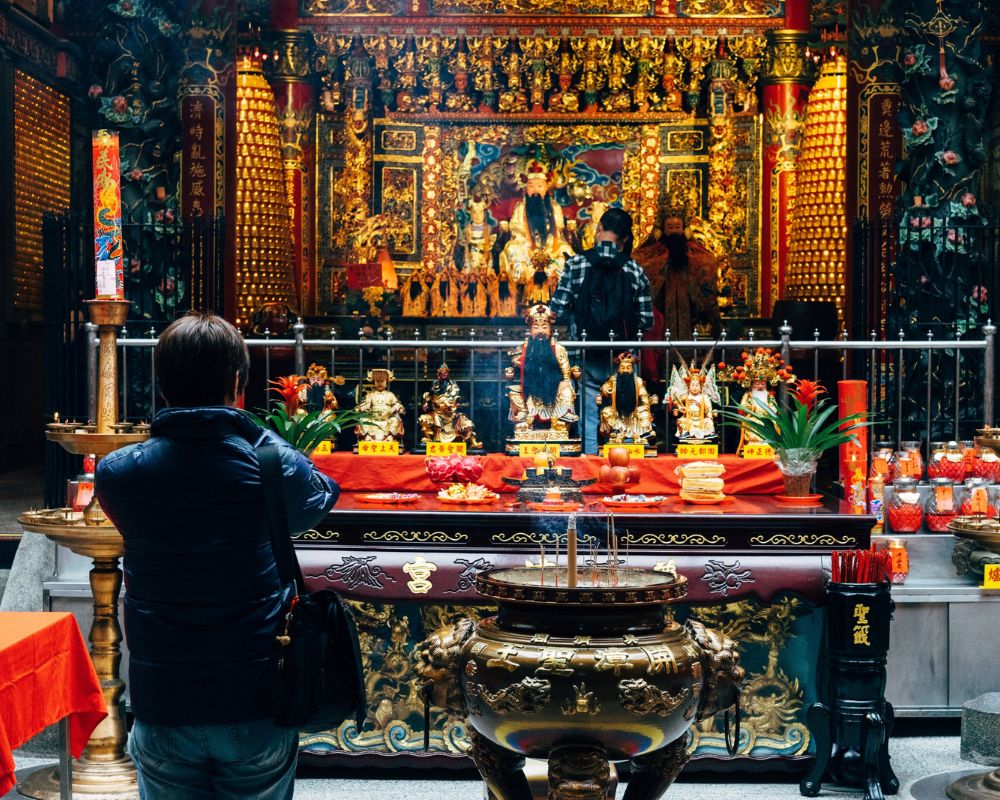
A temple with Taoism architecture
4. Buddhism
Vietnamese Buddhism is a complex and multifaceted tradition that has woven together various strands of Buddhist thought, absorbing and adapting influences from both India and China. It addresses societal norms and ethics, much like Confucianism, while also exploring the broader human condition and the quest for enlightenment.
This synthesis of Buddhist traditions is mirrored in the Vietnamese cultural practice of selecting auspicious dates for significant life events, which reflects a belief in the influence of timing and astrology on one's future.
This practice underscores the deep integration of spiritual beliefs into the fabric of daily life in Vietnam. Consulting astrologers to choose the "right" time for major life decisions, such as weddings or moving into a new home, is a serious and costly affair.
The advice of astrologers is often followed meticulously, demonstrating the profound respect and importance placed on these spiritual consultations, even when they necessitate inconvenient actions like moving at unusual hours.
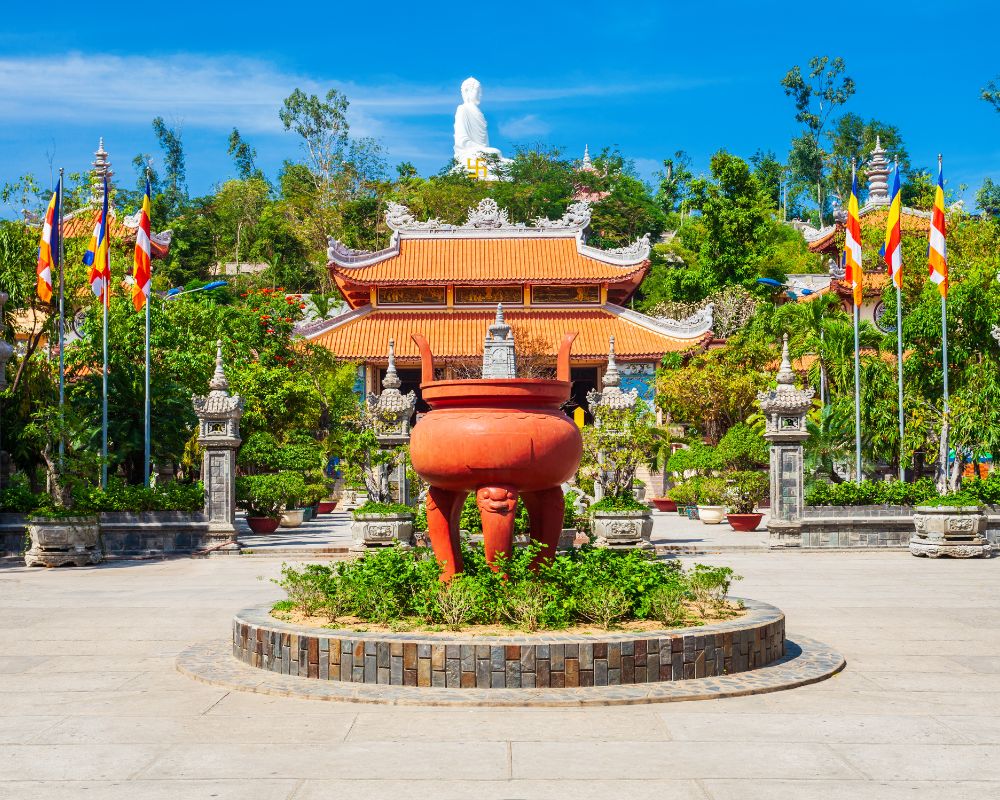
Long Son pagoda in Nha Trang
From the 2nd to the 10th centuries, the landscape of Buddhism in Vietnam was marked by the peaceful coexistence of the A-Ham (Agama) and Thien (Zen) sects. Over time, Thien Buddhism, with its focus on meditation, self-discipline, and mindfulness, gained a stronger foothold.
This form of Buddhism resonated with the Vietnamese people, aligning with the Mahayana tradition's capacity to adapt to the cultural nuances of different countries, including China, Japan, Korea, and Vietnam.
Thien Buddhism's emphasis on direct experience and practice over theoretical knowledge appealed to the Vietnamese, fitting well with their pragmatic and inclusive spiritual outlook.
This tradition has played a significant role in shaping the spiritual landscape of Vietnam, influencing not just religious practices but also the philosophical and ethical dimensions of Vietnamese culture.
The adaptability and resilience of Thien Buddhism reflect the broader characteristics of Vietnamese spirituality, with its capacity to harmonize diverse influences and maintain a coherent yet flexible spiritual identity.
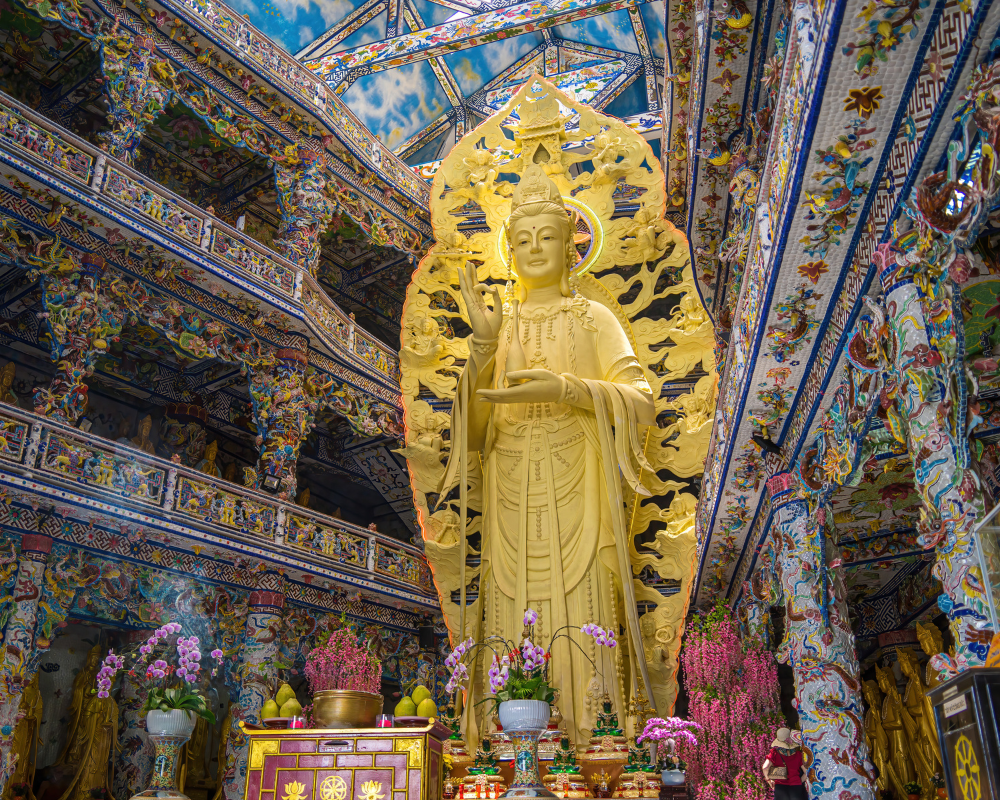
Linh Phuoc Pagoda at Dalat
Mahayana Buddhism's openness, suggesting that both laypeople and clergy can achieve nirvana, contrasts with the Theravada tradition's more orthodox view, which reserves this attainment for monks and nuns.
Yet, despite these doctrinal differences, both branches coexist in Vietnam, with Theravada practices also present, especially in the country's southern regions.
The appeal of Buddhism in Vietnam goes beyond its complex cosmology, deeply entwined with the country's cultural practices. Mahayana Buddhism's rituals and imagery seamlessly integrated with Vietnamese indigenous beliefs, including animism and the teachings of Confucianism and Taoism.
This syncretism allowed Mahayana saints to be venerated alongside animist spirits, illustrating the fluid and inclusive nature of Vietnamese spirituality.
5. Hoa Hao
Hoa Hao Buddhism, founded in 1939 by Huynh Phu So, offers a unique perspective within the Buddhist tradition. With Huynh regarded as a prophet, Hoa Hao Buddhism is seen as an extension of the 19th-century Buu Son Ky Huong movement, drawing spiritual inspiration from the That Son mountain range.
With approximately 2 million followers, mostly concentrated in the Mekong Delta, Hoa Hao Buddhism emphasizes practical and home-based practice over temple worship. This approach promotes simplicity and modesty in religious ceremonies, prioritizes aid to the poor, and eschews the costs and complexities of pagoda construction and elaborate rituals.
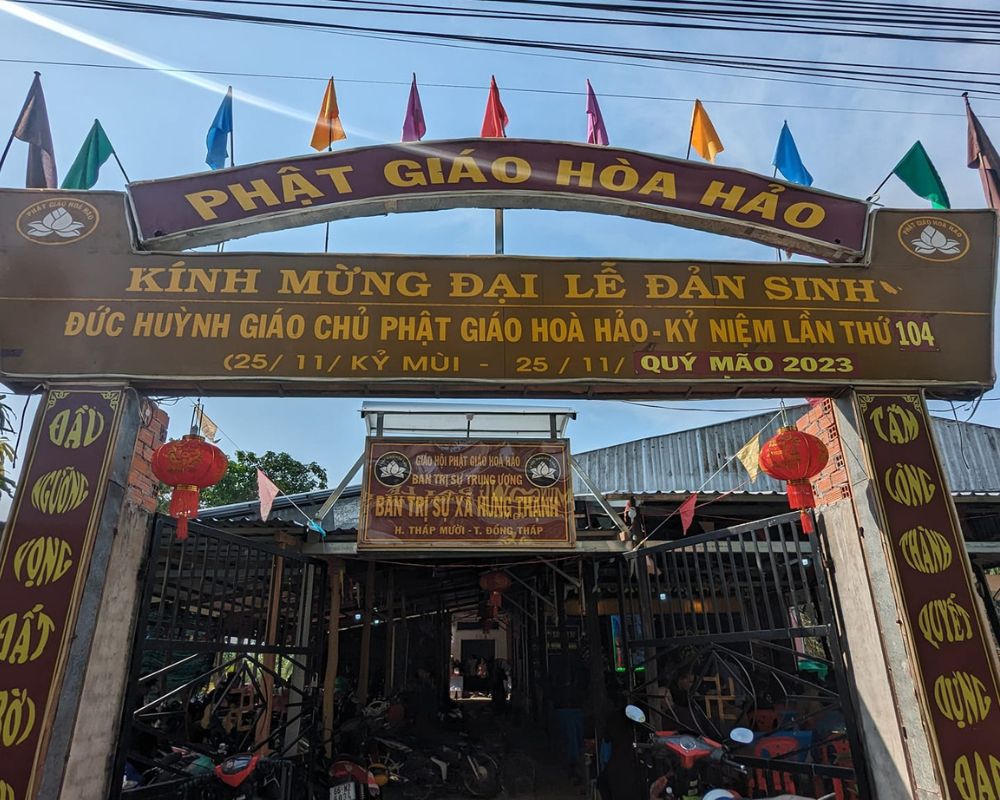
Dan Sinh festival of Hoa Hao
Both Catholicism and Hoa Hao Buddhism in Vietnam showcase the country's religious diversity and the capacity of its people to embrace a variety of spiritual paths. This blend of beliefs and practices not only reflects the historical and cultural complexities of Vietnam but also illustrates the dynamic nature of its spiritual life.
6. Christinaity
Vietnam's religious landscape is complex and historically layered, with Christianity playing a significant role amidst this diversity. From the early footfalls of Western missionaries in the 16th century to the present day, Christianity's journey in Vietnam has been tumultuous, marked by periods of acceptance, conflict, and persecution.
The initial arrival of Portuguese Jesuits in the early 17th century laid the groundwork for Christianity in Vietnam, establishing missions in strategic locations such as Hoian, Danang, and Hanoi.
This introduction of a new, organized religion from the West stirred both curiosity and conflict, leading to a mix of conversions and resistance among the Vietnamese population.
The spread of Catholicism sparked concern among Vietnam's mandarins and ruling classes, who perceived it as a threat to traditional societal structures and beliefs, notably ancestor worship.
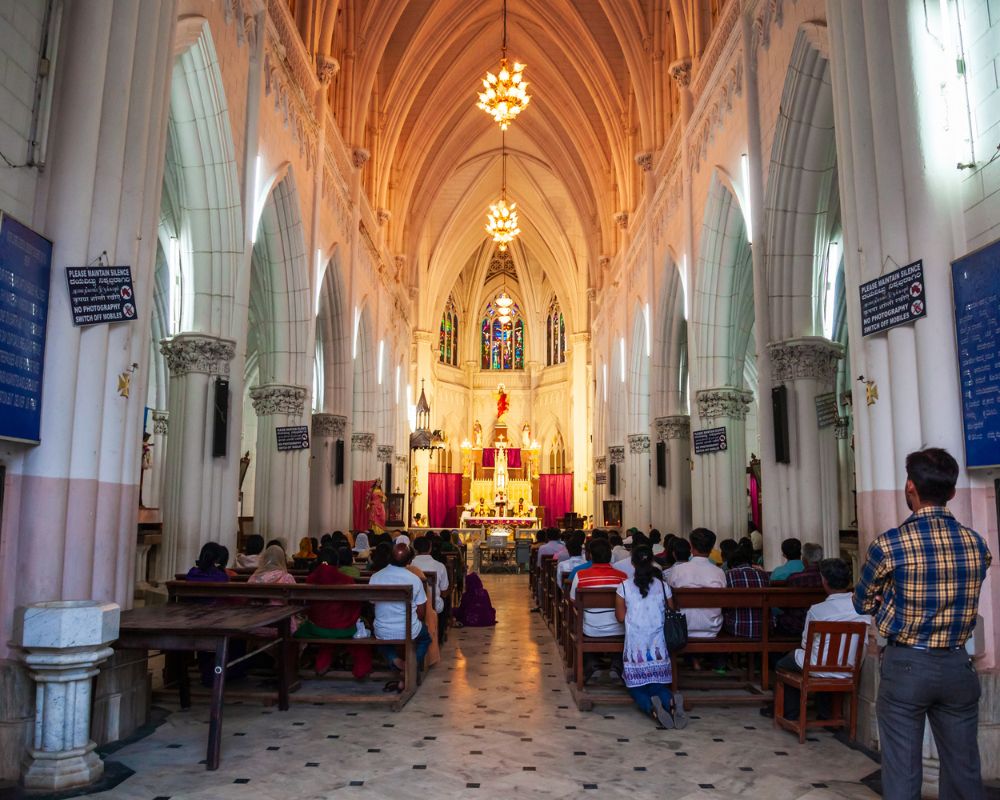
A ceremony in church
This apprehension led to decrees forbidding Christianity and expelling foreign missionaries, particularly under emperors who saw Christianity as a corrupting foreign influence.
Emperor Minh Mang's stringent prohibition of Christianity and subsequent periods of persecution under his successors highlight the tumultuous relationship between the Vietnamese state and the Christian faith.
The situation began to change in the mid-19th century when treaties with the French granted Christians the freedom to practice their faith, though this did not entirely end the struggles faced by the Catholic Church.
The Geneva Agreement of 1954 and the subsequent division of Vietnam saw a mass movement of Catholics from North to South Vietnam, seeking religious tolerance. Since the reunification of Vietnam in 1975, the government has officially recognized the freedom of religion, albeit within the constraints of a socialist republic.
The Catholic Church, while enjoying more freedom, operates under close government surveillance, similar to other religious groups like Protestant hill tribes and Hoa Hao Buddhists.
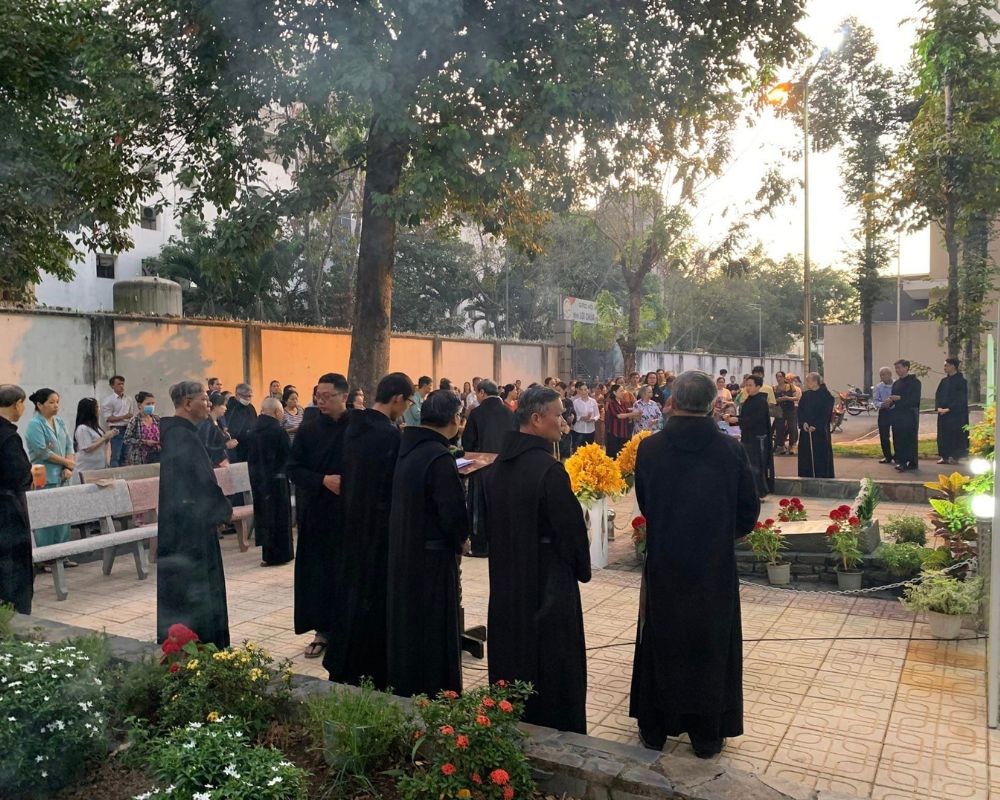
A Christinaity ritual
The rapid growth of Protestantism, particularly among the hill tribes and in urban centers like Ho Chi Minh City, underscores the dynamic nature of Vietnam's religious scene. Despite the significant increase in followers and churches, the government's cautious stance towards Protestantism reflects ongoing tensions between religious practice and state oversight.
The history of Christianity in Vietnam is a narrative of resilience and adaptation, reflecting broader themes of cultural exchange, conflict, and reconciliation within the country's rich religious mosaic.
7. Islam ( Muslim)
In Vietnam, the Muslim population, though small, is primarily made up of the ethnic Cham people and South Asians. The discovery of a stela from the 10th century, marked with Arabic script in the vicinity of Phan Rang along the central coast, stands as the oldest testament to Islam's footprint in the region.
Identifying with Islam, this community practices a version of the religion that diverges from mainstream orthodoxy. Notably, they do not partake in the Hajj pilgrimage to Mecca. While adhering to the Islamic prohibition against pork, they nonetheless consume alcohol and limit their observance of Ramadan to merely three days, rather than the traditional full month.
Moreover, their religious practices are interwoven with elements of animism and Hinduism, reflecting a unique blend of spiritual traditions.

Muslim clothing
8. Ancestor workship
The practice of ancestor worship in Vietnam, rooted in Confucian teachings on filial piety, unites Vietnamese culture across religious lines. It showcases deep respect for ancestors, seen as a key duty of the living.
Altars in homes and businesses for ancestors highlight this widespread practice, involving rituals like offering votive objects to ensure ancestors' well-being in the afterlife, symbolizing a lasting bond between the living and the dead.
Over time, these offerings have evolved, reflecting societal changes and maintaining the tradition's relevance in modern Vietnamese life.

Altar of Ancestor workship
Together, Taoism and ancestor worship illustrate the complexity of Vietnam's spiritual landscape, where diverse religious practices coalesce into a harmonious whole. This blend of beliefs not only enriches the cultural fabric of Vietnam but also fosters a sense of continuity and connection across generations.
9. Whale Workship
The practice of whale worship in Vietnam is a unique and deeply rooted aspect of the country's cultural and spiritual life, highlighting the intricate relationship between humans and nature.
This tradition, centered on the veneration of the whale god Ngu Ong, showcases a blend of respect, fear, and reverence for these majestic sea creatures. Whales are not just seen as animals but as divine protectors that ensure the safety and prosperity of fishermen and their communities.
The Tradition of Whale Worship
Ngu Ong (Whale God): The whale god is a central figure in Vietnamese coastal communities, embodying the protective and benevolent forces of the sea. Ngu Ong is both feared for its immense power and revered for its capacity to safeguard fishermen during their voyages.
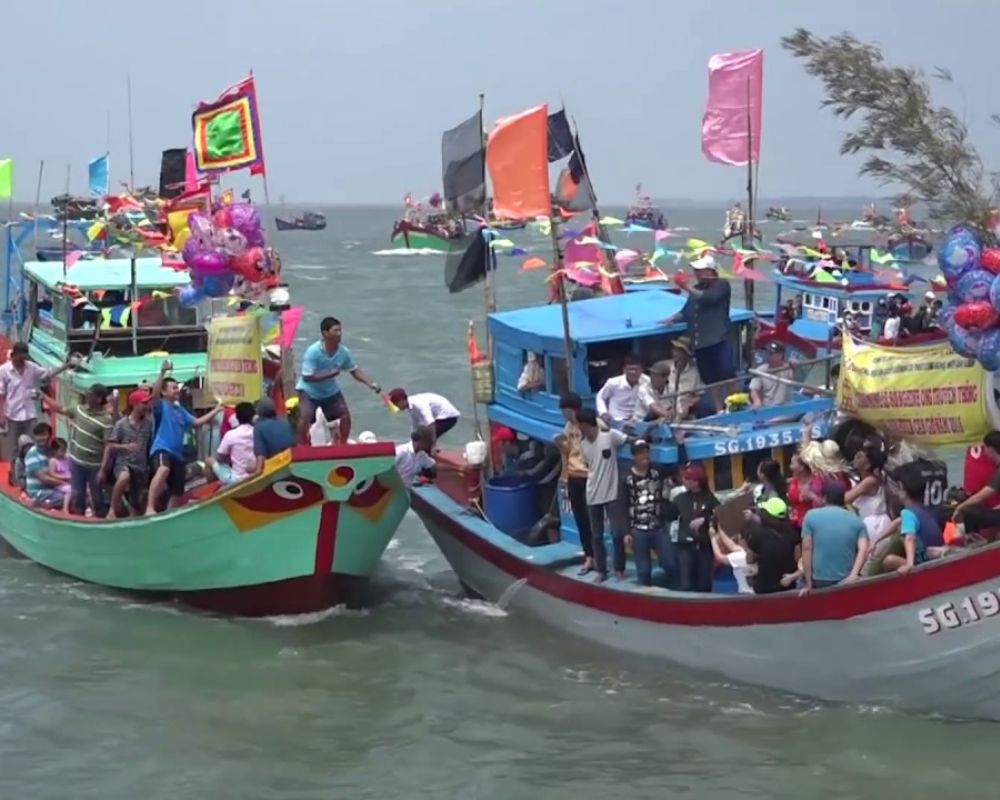
Ngu Ong festival
Respect for Living Whales: Living whales are treated with immense respect and are protected under this tradition. They are seen as manifestations of the whale god, guiding and defending the fishermen from the perils of the sea.
Burial of Deceased Whales: The discovery and burial of a 15-tonne whale in Bac Lieu province in a giant glass tomb exemplifies the profound respect afforded to these creatures. Such burials are conducted with reverence and ceremony, akin to honoring a divine being.
Annual Festival in Danang
Festival Celebrations: The annual whale festival in Danang, held in the third lunar month, is a vibrant and colorful event that pays homage to the whales. It features brightly colored boats and involves the entire community in giving thanks to the whale god for protecting fishermen and ensuring their safe return.
Community Involvement: This festival is not only a religious observance but also a communal event that strengthens bonds among the fishermen and their families. It is a time of gratitude, celebration, and prayer for continued protection and prosperity.
The tradition of whale worship in Vietnam is a testament to the country's rich cultural heritage and its people's enduring reverence for the natural world. It underscores a harmonious coexistence with nature, where whales are not feared as mere animals but honored as divine guardians of the sea.
10. Cao Dai
In the year 1921, a person by the name of Ngo Minh Chieu, who had previously worked as a civil servant for the French colonial government, was given a message from a "superior spirit" known as Cao Dai, which may be translated as High Spirit or Supreme Being.
The current religions left Ngo feeling disillusioned, therefore he was encouraged to establish a new religion that would combine the most prominent creeds from throughout the world.
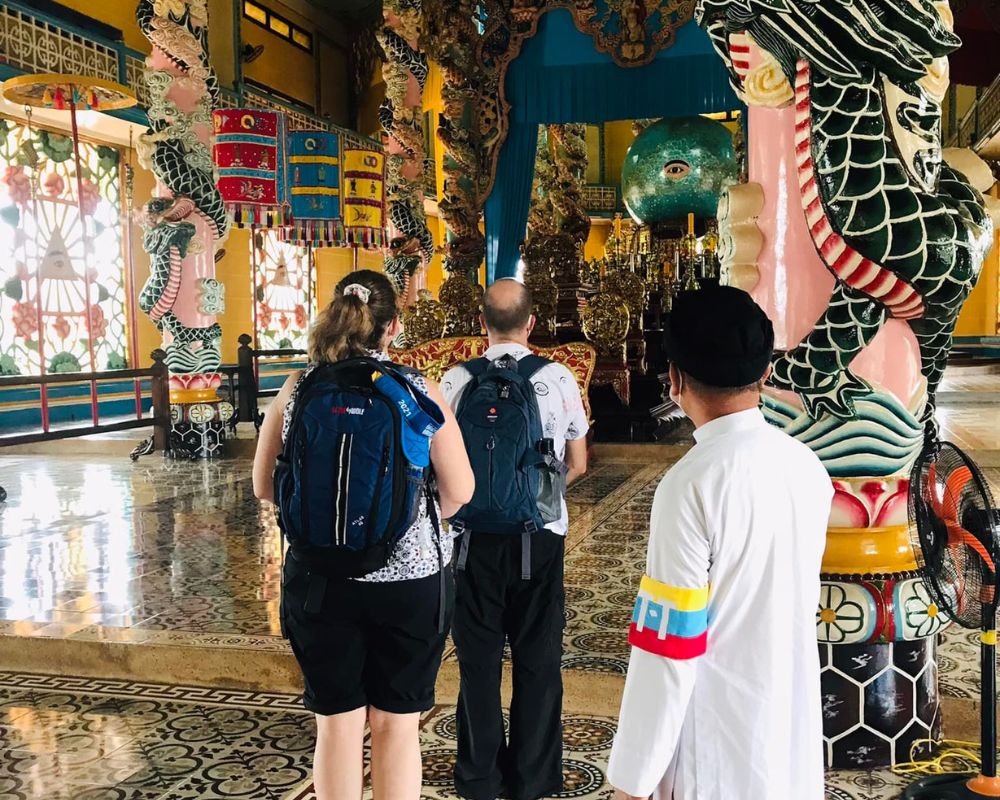
Cao Dai Temple in Tay Ninh
There are around four million people in Vietnam who adhere to the Cao Dai faith at present. Buddhism, Taoism, and Confucianism are all ideologies and teachings that are included in Cao Dai and its practices. Before the existence of God, there was the Tao, which is a source that is unnamed, formless, unchanging, and everlasting. The Tao Te Ching has references to this source.
After that, a Big Bang took place, which resulted in the birth of God. At that time, the cosmos was not yet able to be established, therefore in order to do this, God created yin and yang. Through the process of shedding a portion of himself and assuming control over yang, he manifested the Goddess as Mother Buddha, who would rule over Yin.
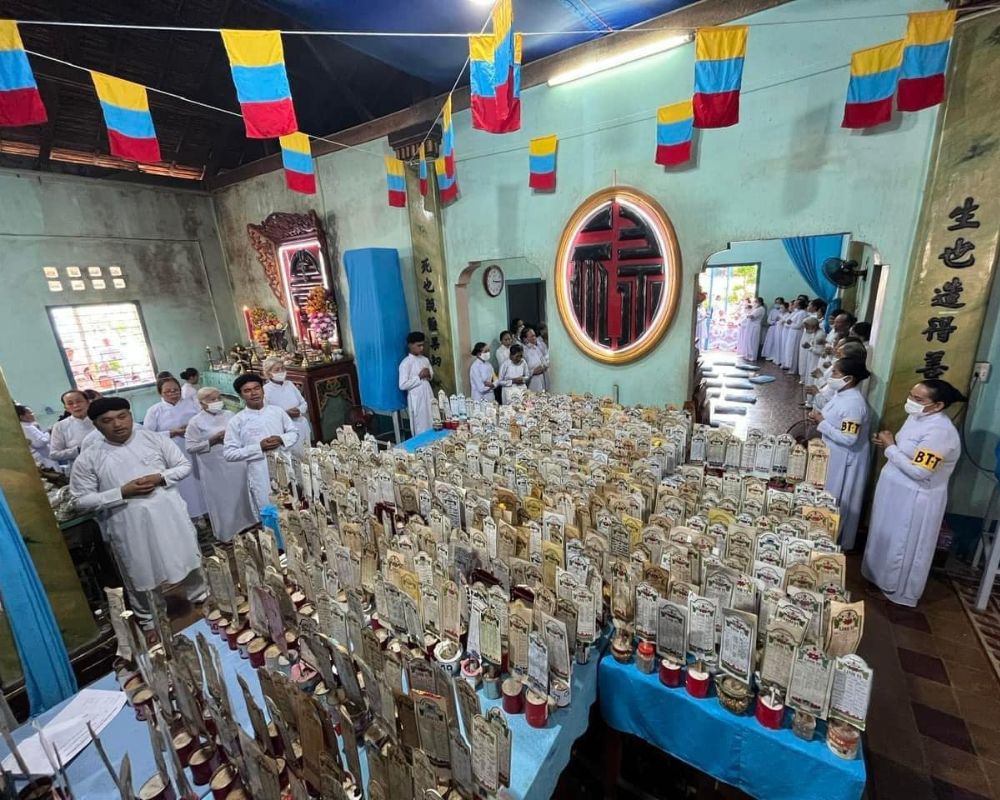
Customs of Caodaism
A diverse group of individuals were the three original prophets of the religion. These individuals were the French novelist Victor Hugo, the leader of the Chinese Nationalist Party Sun Yat-sen, and the Vietnamese poet Trang Trinh.
On the other hand, the extensive list of Cao Dai saints includes notable figures such as William Shakespeare, Joan of Arc, Julius Caesar, René Descartes, and Thomas Jefferson. Graham Greene, a British author, referred to the Cao Dai faith as "a game that had gone on for too long other ideas, written in one of the most complicated scripts that had ever been devised."
Even though a new Vietnamese written language took the place of Chinese script in the 13th century, the Vietnamese continue to be devoted to the old Chinese characters. These letters physically and artistically reflected the meaning and sentiment that was associated with each phrase.
Even though they struggled against the cultural hegemony of China, the Vietnamese selectively filtered and assimilated all that they considered to be the most positive parts. Confucian intellectuals, Buddhist masters, and Taoist diviners commonly accompanied Chinese instructors, some of whom were administrators.
These individuals were typically accompanied by other individuals. These religious influences continue to exist in Vietnam today, as do the faiths that were imported later, such as Hinduism and Islam, which were brought from India, and Christianity, which was brought from Europe and the United States. The Vietnamese absorbed a significant amount of what they had something to give.
